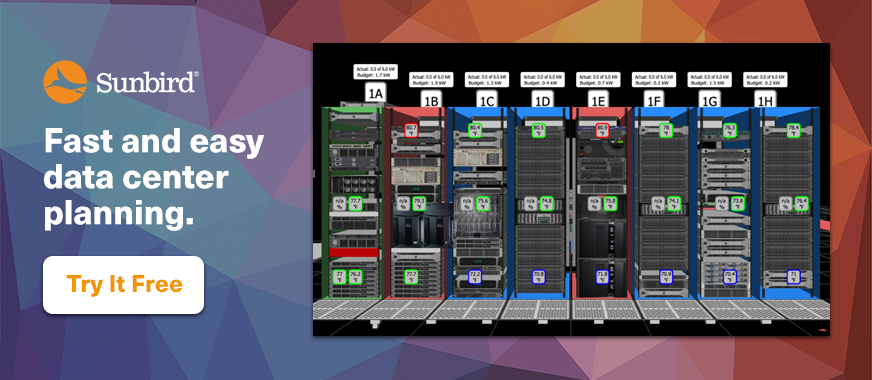Data Center Planning Made Easy: 10 Practical Tips
Data center planning can be a chore. It's often a manual and time-consuming process that involves gathering data that may or may not be accurate from multiple tools. Plus, modern data center environments are increasingly complex and distributed which adds to the challenge.
However, by leveraging modern data center management tools and implementing tried-and-true processes, you can resolve many of the pain points of data center planning, deploy projects faster, and optimize your data center infrastructure.
Follow these 10 tips to more easily plan for future growth and get the most out of your facilities.
1. Maintain accurate asset information
Tracking detailed information about what equipment you have where is necessary for effective data center planning. Legacy tools like Visio and Excel are still commonly used despite being manual, time-consuming, and inaccurate leading to slow rollouts or even failed projects.
Data Center Infrastructure Management (DCIM) software enables easy and accurate asset tracking that simplifies planning. It allows you to track and visualize all your assets with automatic 3D rack elevation diagrams so you can see at a glance where you have rack space for new equipment.
You can even track your inventory of parts and spares to ensure you have enough in inventory to roll out your planned projects.
Plus, with built-in, voice responsive, guided asset auditing leveraging barcode/QR code scanners, you can quickly audit your data centers to keep your asset inventory accurate.
2. Monitor power and environment in real-time
Power is perhaps the most common limiting factor when planning out your data center projects. As such, having real-time data about your power capacity and utilization is incredibly valuable.
With DCIM software, you can understand the capacity and utilization at every hop in your power chain. This helps you avoid situations where you might think you have enough power in a rack to deploy more servers, but the main panel breaker is already near tripping and can’t handle the additional load.
With a built-in ghost server report, you can instantly get a list of all your potential ghost servers that are wasting energy, space, and other resources. Decommissioning these frees up resources that can be used for other projects you are planning.
Plus, power monitoring enables you to ensure your planned projects will maintain three-phase load balance and not cause a loss of redundancy in a failover scenario.
In addition to monitoring power consumption, you should be monitoring the environment. This gives you insight into which cabinets can accommodate new servers without exceeding your temperature and/or humidity guidelines.
3. Track port capacity and cabling
When planning, data center managers typically focus on their assets and space capacity. However, when you consider that an average-sized data center might have tens of thousands of port and cabling components, it becomes obvious that these components also need to be tracked and managed.
If you are planning to install even one server, you must take into account its power supplies, power cords, rack PDU outlets, in-rack patch ports, far-end patch ports, ethernet ports, and patch cords.
DCIM software makes data center connectivity management easy. You can see which cabinets have available data and power ports for new installations, leverage built-in validation to ensure that planned connections are compatible, and conduct impact analysis from any point in a data or power circuit to see if what devices would be effected by changes.
4. Correlate capacity constraints
With a complete DCIM solution, you can visualize and correlate the most common capacity constraints in 2D or 3D floor maps of your data center.
On the interactive floor map, you can select multiple capacity constraints to correlate simultaneously and then see with red-yellow-green color-coding which of your cabinets have capacity. Capacity parameters for each cabinet include used RUs, available RUs, percent full, weight, weight capacity, static load, inlet temperature, relative humidity, measured amps, and budgeted power.
This enables holistic data center capacity planning that eliminates the chance of you reserving space and installing equipment where it cannot be deployed without introducing risk.
5. Perform what-if analysis
What-if analysis enables you to plan more efficiently by seeing the potential impact of projects on your space and power capacity and utilization. This helps you see if you can utilize existing capacity and delay large capital expenditures with minimal effort required.
Understanding which racks have enough capacity to support new equipment before installation can be game-changing for data center planning. Whether you have one or many projects occurring, what-if analysis is a great DCIM software feature to help you get the most out of what you already have. It also gives you the flexibility to try different combinations and locations of equipment in multiple projects to determine which offers you the optimal outcome.
6. Leverage data center dashboards to track the right KPIs
Transform your data center monitoring and operational data into actionable insights that simplify data center planning.
Second-generation DCIM software provides out-of-the-box dashboards for capacity parameters like space, power, cooling, and connectivity. These dashboards provide real-time data center KPIs that enable better decision-making.
Some of the best KPIs to track for data center planning are:
- Capacity by key data center resources (i.e., space, power, cooling, and power/network port connections)
- Resource capacity by logical groups (i.e., function, department, etc.)
- Stranded power capacity per rack
- Available inventory of devices
- Available floor and cabinet space remaining
- Available space by rack unit size
- Rack unit capacity and usage trends
- Days of power capacity remaining
- Cabinet power failover redundancy compliance
- Power trends by cabinet
- Power chain breaker utilization
- Three-phase load balancing percent deviation
- Latest temperature per cabinet
- Delta-T per cabinet
- Cabinets with most free data and power ports
- Data ports usage per connector type
- Data and power ports capacity and usage trends
7. Automate device power budgeting
A common challenge data center professionals face is accurately planning and budgeting rack power capacity. A typical approach is to derate each server’s nameplate value to around 60-70%. Since this is manually estimated, it is often wildly inaccurate and results in stranded capacity and premature expansions.
The new way forward is to use intelligent rack PDUs and DCIM software with an Auto Power Budget feature that automatically calculates power budget profiles for each device instanced based on how they are used in your environment. With accurate device power budgets that are automatically updated every week, you will likely find that you can deploy more servers in your existing racks to defer new cabinet buildouts or even building your next data center.
Comcast leveraged this feature to get 40% more utilization out of their existing resources.
8. Leverage intelligent capacity search
Planning where and if you can install more servers can be tricky without the right tools and data. If done manually, it takes time and careful analysis and the risk of human error is always present. You may even have to physically visit the data center to see where you have capacity.
With DCIM software, provisioning is a breeze. The intelligent capacity search feature allows you to locate capacity for new equipment with a click. Simply enter the device make and model you want to deploy and the software will show you each cabinet that has enough space, power, and port capacity for that exact asset. Pick a cabinet, and you can reserve the all the necessary resources so they are blocked from other projects.
9. Streamline infrastructure project management
Most planning in the data center is project-based, and project management traditionally involves painful swivel chair management with multiple spreadsheets, online forms, ticketing systems, and project management tools. This causes project delays and introduces the risk of inaccurate data due to human error.
DCIM software with an infrastructure project management module provides a new way to consolidate tools with a single source of truth that streamlines processes and enables data-driven collaboration to help ensure every project is completed on time and within the budget. You can plan more efficiently by projecting estimated costs, start and end dates, and the required resources. Requests and work orders can also be processed faster.
Juggling multiple projects at once is now effortless. You can easily view, search, and sort your infrastructure projects and track and manage your projects’ lifecycle, requirements, items, owner, requests, work orders, and more.
10. Reduce manual effort and increase accuracy with system integration
Data center planning traditionally requires a lot of manual effort. Typically, there are multiple tools data center professionals need to go to get all the information they need to plan out their projects.
However, leading data center professionals driving data center automation by integrating modern DCIM software with out-of-the-box connectors that automatically populate data in the appropriate systems, thereby reducing manual data entry and improving collaboration between Facilities, Data Center Ops, and IT teams to ensure a successful project.
DCIM software can seamlessly integrate with your CMDB such as ServiceNow, Jira, BMC, and Ivanti/Cherwell, ticketing system such as ServiceNow and Jira, Dev Ops tools such as VMware, Ansible, Chef, Jenkins, and Puppet, and more. With all the information you need centralized in your DCIM tool, you have a single pane of glass from which to plan all your data center infrastructure projects.
Bringing It All Together
The key to fast and easy data center planning is having the right information and having easy access to it.
DCIM software allows you centrally track and manage all your resources and delivers the data you need at a glance to dramatically simplify planning and enable better decision-making. Follow these tips and you’ll be able to more effectively plan for future growth and optimize your data center.
Want to see how Sunbird’s second-generation DCIM software can dramatically simplify your data center planning efforts? Get your free test drive today!






























